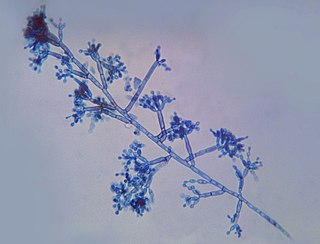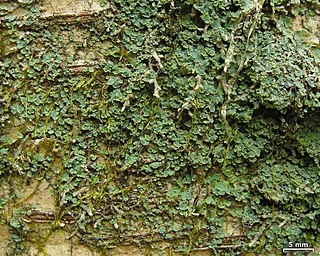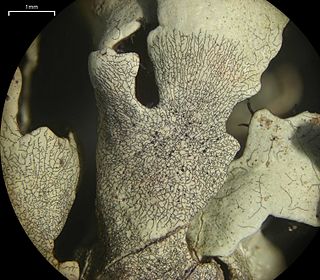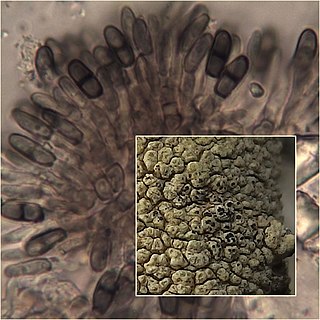Scutula is a genus of lichenicolous fungi in the family Ramalinaceae.

The Chaetothyriales are an order of ascomycetous fungi in the class Eurotiomycetes and within the subclass Chaetothyriomycetidae. The order was circumscribed in 1987 by mycologist Margaret Elizabeth Barr-Bigelow.

Lichinales is the sole order of ascomycete fungi in the class Lichinomycetes. It contains three families: Gloeoheppiaceae, Lichinaceae, and Peltulaceae. Most species are lichenized. Lichinales was proposed in 1986 by German lichenologists Aino Henssen and Burkhard Büdel. The class Lichinomycetes was created by Valérie Reeb, François Lutzoni and Claude Roux in 2004.

Stigmidium is a genus of lichenicolous (lichen-eating) fungi in the family Mycosphaerellaceae. The genus was circumscribed by Italian botanist Vittore Benedetto Antonio Trevisan de Saint-Léon in 1860, with Stigmidium schaereri assigned as the type species.

Heteroplacidium is a genus of lichen-forming fungi in the family Verrucariaceae. The genus was circumscribed by Austrian lichenologist Othmar Breuss in 1996 with Heteroplacidium imbricatum assigned as the type species. It was proposed as a segregate of Catapyrenium. Other morphologically similar genera are Neocatapyrenium, Placidium, and Scleropyrenium, although molecular phylogenetic analyses indicate that they are independent monophyletic lineages within the Verrucariaceae.
Endococcus is a genus of lichenicolous (lichen-dwelling) in the family Lichenotheliaceae. It has 44 species. The genus was circumscribed by the Finnish botanist William Nylander in 1855. Although at least one source places the genus in the Verrucariaceae, a 2016 study of the type species, Endococcus rugulosus, determined that it should instead be placed in the family Lichenotheliaceae of the order Dothideales; this classification echoes a placement proposed in 1979 by David Hawksworth.
Didymocyrtis is a genus of lichenicolous fungi in the family Phaeosphaeriaceae. The genus was circumscribed by Finnish lichenologist Edvard August Vainio in 1921, with Didymocyrtis consimilis assigned as the type species.

Normandina is a genus of lichen-forming fungi in the family Verrucariaceae. It has three species:
Llimoniella is a genus of fungi in the family Cordieritidaceae. The genus was circumscribed by lichenologists Josef Hafellner and Père Navarro-Rosinés in 1993.

Bryoria is a genus of lichenized fungi in the family Parmeliaceae. Many members of this genus are known as horsehair lichens. The genus has a widespread distribution, especially in boreal and cool temperate areas.
Xenonectriella is a genus of lichenicolous fungi in the family Nectriaceae. The genus was circumscribed by lichenologist Josef Karl Weese in 1919, with Xenonectriella lutescens assigned as the type species.

Lichenostigma is a genus of fungi. It includes several species which are lichenicolous.

The Tephromelataceae are a family of lichenized fungi in the order Lecanorales. The family was circumscribed by Austrian lichenologist Josef Hafellner in 1984. Tephromelataceae comprises the genera Tephromela, Calvitimela, Mycoblastus and Violella, which together constitute a well-supported monophyletic group.
Dacampia is a genus of fungi in the family Dacampiaceae. It contains 15 species. The genus was circumscribed in 1853 by Italian lichenologist Abramo Bartolommeo Massalongo, with Dacampia hookeri assigned as the type species. The genus name honours Italian naturalist Benedetto de Dacampo (1787–1851).

Polycoccum is a genus of lichenicolous fungi in the family Polycoccaceae. It has about 60 species.

Silobia rufescens is a lichenized fungus, with a dark gray or brown crust-like appearance. It is widespread, and grows on siliceous rock. S. rufescens is in the genus Silobia, which is segregated from the genus Acarospora due to its budding apothecia with only lateral exciple.

Pier Luigi Nimis is Professor of Botany at the University of Trieste in Italy. He specialises in lichenology and phytogeography, including the uses of lichens as indicators of pollution and devising methods for web-based identification keys.
Pyrenidium is a genus of lichenicolous (lichen-dwelling) fungi. It is the only genus in the family Pyrenidiaceae. It has 13 species.

Minutoexcipula is a genus of lichenicolous (lichen-dwelling) fungi of uncertain familial placement in the order Chaetothyriales. It has eight species. The genus was circumscribed in 1994 by M. Violeta Atienza Tamarit and David Leslie Hawksworth, with Minutoexcipula tuckerae assigned as the type species. The genus is characterized both by its black convex sporodochia-like conidiomata, as well as the well-differentiated exciple on these structures.












